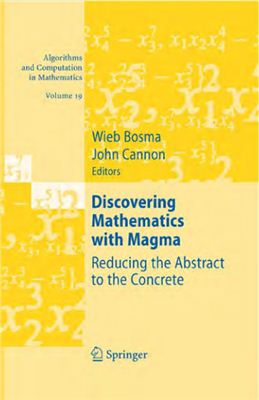Издательство Springer, 2006, -399 pp.
The appearance of this volume celebrates the first decade of Magma, a new computer algebra system launched at the First Magma Conference on Computational Algebra held at Queen Mary and Westfield College, London, August 1993.
This book introduces the reader to the role Magma plays in advanced mathematical research. Each paper examines how the computer can be used to gain insight into either a single problem or a small group of closely related problems. The intention is to present sufficient detail so that a reader can (a), gain insight into the mathematical questions that are the origin of the problems, and (b), develop an understanding as to how such computations are specified in Magma. It is hoped that the reader will come to a realisation of the important role that computational algebra can play in mathematical research. Readers not primarily interested in using Magma will easily acquire the skills needed to undertake basic programming in Magma, while experienced Magma users can lea both mathematics and advanced computational methods in areas related to their own.
The core of the volume comprises 14 papers. The authors were invited to submit articles on designated topics and these articles were then reviewed by referees. Although by no means exhaustive, the topics range over a considerable part of Magma’s coverage of algorithmic algebra: from number theory and algebraic geometry, via representation theory and computational group theory to some branches of discrete mathematics and graph theory. The papers are preceded by an outline of the Magma project, a brief summary of the papers and some instructions on reading the Magma code. A basic introduction to the Magma language is given in an appendix.
Preface
Magma: The project
Discovering mathematics: About this volume II
How to read the Magma code?
Some computational experiments in number theory
Applications of the class field theory of global fields
Some teary Diophantine equations of signature (n,n,2)
Studying the Birch and Swinnerton-Dyer conjecture for modular abelian varieties using Magma
Computing with the analytic Jacobian of a genus 2 curve
Graded rings and special K3 surfaces
Constructing the split octonions
Support varieties for modules
When is projectivity detected on subalgebras?
Cohomology and group extensions in Magma
Computing the primitive permutation groups of degree less than 1000
Computer aided discovery of a fast algorithm for testing conjugacy in braid groups
Searching for linear codes with large minimum distance
Colouring planar graphs
Appendix: The Magma language
The appearance of this volume celebrates the first decade of Magma, a new computer algebra system launched at the First Magma Conference on Computational Algebra held at Queen Mary and Westfield College, London, August 1993.
This book introduces the reader to the role Magma plays in advanced mathematical research. Each paper examines how the computer can be used to gain insight into either a single problem or a small group of closely related problems. The intention is to present sufficient detail so that a reader can (a), gain insight into the mathematical questions that are the origin of the problems, and (b), develop an understanding as to how such computations are specified in Magma. It is hoped that the reader will come to a realisation of the important role that computational algebra can play in mathematical research. Readers not primarily interested in using Magma will easily acquire the skills needed to undertake basic programming in Magma, while experienced Magma users can lea both mathematics and advanced computational methods in areas related to their own.
The core of the volume comprises 14 papers. The authors were invited to submit articles on designated topics and these articles were then reviewed by referees. Although by no means exhaustive, the topics range over a considerable part of Magma’s coverage of algorithmic algebra: from number theory and algebraic geometry, via representation theory and computational group theory to some branches of discrete mathematics and graph theory. The papers are preceded by an outline of the Magma project, a brief summary of the papers and some instructions on reading the Magma code. A basic introduction to the Magma language is given in an appendix.
Preface
Magma: The project
Discovering mathematics: About this volume II
How to read the Magma code?
Some computational experiments in number theory
Applications of the class field theory of global fields
Some teary Diophantine equations of signature (n,n,2)
Studying the Birch and Swinnerton-Dyer conjecture for modular abelian varieties using Magma
Computing with the analytic Jacobian of a genus 2 curve
Graded rings and special K3 surfaces
Constructing the split octonions
Support varieties for modules
When is projectivity detected on subalgebras?
Cohomology and group extensions in Magma
Computing the primitive permutation groups of degree less than 1000
Computer aided discovery of a fast algorithm for testing conjugacy in braid groups
Searching for linear codes with large minimum distance
Colouring planar graphs
Appendix: The Magma language

